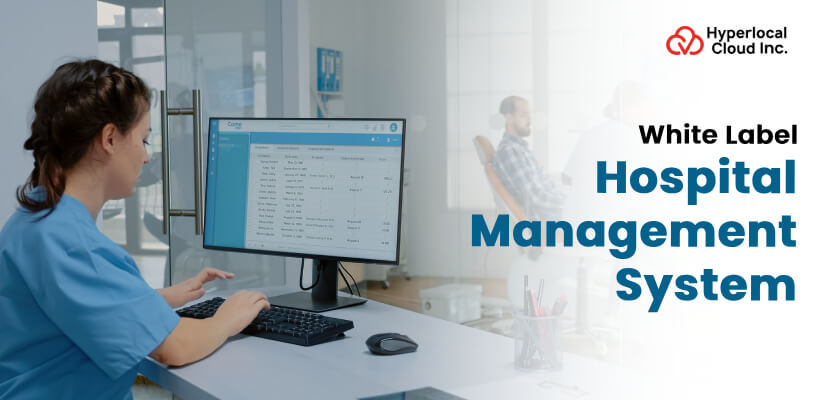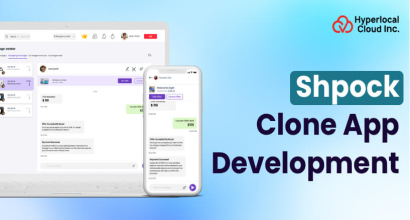The healthcare sector has been swiftly embracing digital solutions in order to enhance patient care and efficiency in its operations. As the global hospital management system market is expanding tremendously, an increasing number of healthcare facilities are transitioning from paper-based processes in favor of the use of sophisticated software programs.
The transformation is being fuelled by rising patient volumes, the growing demand for quality healthcare, and the need for accurate data management. The current hospital management systems combine AI, telemedicine, and cloud technology and bring healthcare delivery nearer, safer, and more affordable to all.
What A Hospital Management System Entails
A hospital management software is a computer-based system that assists the management of the hospital to operate effectively and efficiently. It takes care of all patient records, appointment booking, billing, inventory, and staff organization. This software saves time and minimizes errors and paperwork for care workers. This system facilitates the access of patient information by doctors and nurses within seconds, organizes patient health records, and organizes hospital operations. Holistically, the whole process will be patient-centered, and the hospital management will be simplified and easier.
Start your journey to streamlined healthcare operations today
How Does A Hospital Management System Operate?
A hospital management system works on the principle of linking various departments of a hospital using a centralized electronic system. At this point, it is simplified:
1. Patient Registration and Records
Upon the arrival of a patient, his/her data is recorded in the system, forming a digital profile. This contains personal information, medical history, allergies, and past treatment. This information can be accessed by all authorized individuals, regardless of department, in real-time.
2. Appointment Scheduling
The system is applied during the process of booking appointments with doctors and other departments. Patients are able to book appointments, and the software will give them a time slot, and it will send reminders, hence no one will be expected to make two bookings.
3. Electronic Medical Records
Clinical reports on patients are digitized and updated by nurses and doctors at the time of consultation. They will be in a position to make an insertion of a diagnosis, prescription, tests, and a treatment plan. Such data also has a secure location and could be accessed anytime there is a necessity.
4. Billing and Payments
The system automatically computes the bills depending on the services offered, medications, and procedures. It creates invoices, pays, and controls insurance claims, for which the financial process becomes clear and error-free.
5. Inventory Management
It tracks stock of medicines, medical supplies, and equipment. When the items are low, the system reminds employees to order the items so that the hospital does not run out of the necessary materials.
6. Laboratory and Pharmacy Integration
The system sends test requests directly to the lab upon request by the doctors. Findings are digitally uploaded and sent through emails to the physician. On the same note, prescriptions are electronically sent to the pharmacy for preparation.
7. Staff Management
The system will enable one to monitor the schedules, rotations on duty, attendance, and remuneration of the staff. It also helps the administrators to properly control the human resources, and staffing is sufficiently addressed at a specific moment.
Advantages Of Investing In A White-Label Hospital Management System
A white-label hospital management software platform will be a pre-built software platform that is re-branded and adapted to your specifications. Here are the key advantages of investing in such a system:
1. Cost-Effective Solution
To create a complete hospital management system, it is very expensive in terms of the money needed to employ developers, designers, and testing personnel. A white-label solution is far cheaper as the fundamental software is already developed. You simply pay to customize and brand, saving you thousands of dollars on development costs.
2. Quick Deployment
Software development may require months or even years. When using a white-labeled system, you will be able to roll out your branded hospital management solution in weeks. This is a fast implementation, and hospitals can enjoy the system almost instantly.
3. Proven and Tested Technology
Several healthcare facilities have already tried and implemented white-label systems. This implies that the bugs are corrected, the features are enhanced, and the system is dependable. It is a proven solution, and not trial-and-error software.
4. Regular Updates and Maintenance
The developers continue to add features and security patches to the software, which continuously improve the software. As a white-label user, you will receive all these updates automatically at no extra cost of development and maintain your system now in line with the industry standards.
5. Customization Options
Although the basic functionality is already ready, customization is provided to white-label systems so that the system fits your needs. You can customize features, add your branding, favorite color schemes, and amend workflow to meet the varied needs of the hospital.
6. Scalability
The white-label system can easily be expanded as your business expands and you start acquiring more clients in hospitals. It is not necessary to rebuild the entire platform to add more users, facilities, and features.
7. Focus on Your Core Business
You will be able to use time and resources to develop software, but you can also spend them on marketing, serving the customers, and developing your hospital network. The white-label provider deals with the technical complexities.
8. Competitive Advantage
Owning your branded hospital management system will make or create your identity in the market of healthcare technology. It makes you a provider of a complete solution and not a reseller.
Key Features Of A Hospital Management System
The following are the features that facilitate the different panels of the hospital management system:
Admin Panel Features
1. Dashboard and Analytics
Hospital statistics, patient admissions, revenue rates, bed occupancy, and department performance in real-time with visual charts to facilitate fast decision-making.
2. User and Role Management
Creations of user accounts, distribution of specific roles and permissions, administration of access levels, and access to information that is relevant to the role of staff members only.
3. Department Management
Establish and run departments of the hospital, staffing of departments, allocating resources, timetables, and performance of the departments in an elaborate tracking system.
4. Financial Oversight
Track revenue collection, pending payments, and insurance claims, generate financial reports, set service prices, and billing rules throughout the hospital.
5. Appointment Configuration
Establish appointment times, consultation time intervals, physician scheduling, holiday hours, and emergency appointment systems for each department.
6. Report Generation
Produce detailed patient reports, revenue reports, employee reports, departmental reports, bed occupancy, and compliance with regulatory reports in different formats.
7. System Configuration
Customize the system settings, set prescriptions and report templates, and integrations with external applications, as well as automated backup schedules.
8. Security and Audit Logs
Introduce access controls, set encryption parameters, and monitor all user actions using audit logs, as well as adhere to healthcare data privacy laws.
9. Inventory Management
Control stock of medicines and supplies in the hospitals and hospitals worldwide, low-stock notifications, purchase orders, maintenance of equipment, and relations with suppliers.
10. Communication Tools
Announcements to employees, notifications of new changes in the policy, maintenance of internal messages, and automated reminders to patients and employees.
Doctor Panel Features
1. Personal Dashboard
A tailored personal dashboard enables you to glance through your schedule of the day, appointments booked, tasks yet to be done, patient alerts, and the overview of the workload for the efficient management of the day.
2. Patient Medical Records
Be able to retrieve patient history in moments, in particular, their previous diagnosis, medications, allergies, chronic diseases, surgeries, and their family's medical history.
3. Electronic Prescription
Prescribe digital methods. Also, include the medicine details, check for drug interactions and allergies, use prescription templates, and finally, by email or any other electronic method, send the prescription to the pharmacy immediately.
4. Appointment Management
Appointment scheduling should be very simple if you have access to appointments along with the patient's details. This includes rescheduling if necessary, marking attendance, managing availability, and setting follow-up appointments.
5. Lab Test Ordering
Order laboratory and imaging tests, specify the level of urgency, provide the clinical signs, and be informed through automated notifications when test results are ready.
6. Diagnosis Documentation
Document patient symptoms, clinical findings, diagnoses with ICD codes, treatment plans, and track patient progress for different visits in a systematic way.
7. Patient Notes
Maintain detailed records of the clinical history for every visit, document the findings of the physical examination, record the vital signs, and treatment responses for the future.
8. In-Patient Management
You may also write admission notes, daily progress updates, changes in treatment plans, and medication orders, besides reviewing nursing observations and preparing discharge summaries for patients in the hospital.
9. Teleconsultation
Talk to patients through a remote video call, share the screen for explanation, give medical advice, and manage the follow-ups without the necessity of a physical visit.
10. Medical Certificate Generation
Create the medical certificate of leave, fitness certificates, medico-legal reports, and other medical documents quickly with the help of templates while professionally adhering to the standards.
Patient Panel Features
1. Online Appointment Booking
It is possible to book an appointment by choosing the doctor of your preference, the specialty, the date, and the time slot with the availability of real-time, instant confirmation, and appointment details.
2. Medical Records Access
Get the chance to read your entire health history, including previous diagnoses, treatment summaries, surgical records, and even chronic diseases, and share this information with other healthcare providers.
3. Test Results Viewing
Get access to laboratory, imaging, and other diagnostic results once they are confirmed, save them in PDF format, and see the values that are out of the normal range highlighted.
4. Prescription Access
Access all the prescriptions to be fulfilled that are both past and present; also, you can check the medication info, such as the dosage and the duration, and get reminders for medication refills.
5. Bill Payment
Understand bills thoroughly with the help of charge breakdowns, pay online using different methods, get your receipts downloaded, keep a record of insurance claims, and payment history.
6. Appointment Reminders
Some of these automated messages for appointments can be received by the patients as SMS, email, or app notifications, plus they can be alerts for medication refills and lab tests as well.
7. Teleconsultation Access
An individual is enabled to organize a video session with a doctor in the comfort of their home by means of a straightforward video platform; thus, a journey is not necessary, and confidentiality is maintained during virtual visits.
8. Health Document Upload
Add medical reports from outside, prescriptions from other facilities, insurance papers, and identification proofs to create a complete health record.
9. Family Member Management
It is possible to keep a record of the health of several members of the family through the account of one person, make appointments for the children, and monitor the health of the family in one place.
10. Feedback and Ratings
Users are allowed to provide ratings to doctors and services after their consultations, give feedback regarding the hospital experience, report issues, and contribute to the overall service quality improvement.
Speak to a specialist about white label hospital solutions\
AI-Powered Capabilities In Hospital Management Solutions
The below are the AI-powered capabilities that companies can embed through the API into this hospital management system:
1. Intelligent Appointment Scheduling
AI assesses doctor availability, patient preferences, and appointment history to determine the most suitable time slots, predict no-shows, and, therefore, as a result, change the appointments to the times with less waiting and more efficiency without any intervention.
2. Predictive Patient Analytics
AI analyzes patient data to estimate health risks, disease progression, and the chances of readmission, giving doctors the opportunity to do preventive and proactive care before the patients' conditions get worse.
3. Medical Diagnosis Assistance
AI looks at a patient's symptoms, medical history, and lab reports and provides the most likely diagnosis along with recommended tests. At the same time, it notifies the physician if the patient has any potential drug interactions or is allergic to any substance to help the doctor make a safe decision for the treatment.
4. Automated Billing and Claims Processing
With the help of AI, from the services that have been rendered, accurate bills are automatically created, errors in coding are detected, insurance claims are processed quickly, fraudulent billing activities are identified, and the manual paperwork that takes up a lot of time is significantly reduced.
5. Chatbot for Patient Support
AI-enabled chatbots intervene and take care of the most frequently asked questions of the patients at any time of the day, help with booking appointments, give the necessary advice regarding medications, and, in case of urgency, provide the fastest route to the appropriate medical staff immediately.
6. Resource Optimization
AI forecasts patient admission rates, bed allocation is done efficiently, staff scheduling is coordinated according to the work pattern of the employees, medical tools are used effectively, and in this manner, the hospital cuts down on its operational costs.
Hospital Management Software Development Workflow
In order to develop the best hospital management software, it is required to follow the steps given below:
1. Requirement Analysis and Planning
The development team, by conducting meetings with the hospital stakeholders, that is, the administration, the medical doctors, the nurses, and the staff, wants to grasp their precise requirements, detect problems in the existing processes, describe the characteristics required for each department, and prepare a detailed project plan with timelines and cost estimates.
2. System Design and Architecture
Engineers map out the detailed technical design of a system, come up with the database schema that will hold the patients and hospital data securely, prepare UI layouts for various user groups, identify system workflows, and choose suitable technologies and frameworks that will ensure both scalability and security.
3. UI/UX Design
The team of designers designs user-friendly interfaces for all panels, making sure navigation is problem-free, creates wireframes and prototypes demonstrating the user-system interaction, selects color schemes and layouts that ease the user's eyes, thus benefiting the staff working for long hours, and makes sure the design is logical even for users without technical backgrounds.
4. Development and Coding
The developers work on the coding part of the software. Developers usually follow two ways to develop the software. One is custom-based, and the other is a white-label solution. Here are the differences between the two:
| Features | Custom-Based Solution | White Label Solution |
| Development Time | Takes months to build from scratch | Ready to use in days or weeks |
| Cost | High upfront investment required | Lower development cost |
| Customization | Fully tailored to your specific needs | Limited to existing features and templates |
| Ownership | You own the entire codebase | You rebrand existing software |
| Maintenance | Your team handles all updates and fixes | Provider manages updates and technical support |
5. Testing and Quality Assurance
Quality assurance staff test the features exhaustively to locate bugs and fix them, and carry out security testing to forestall data breaches, evaluate the system's capability to work under extreme loads thus it won't be the case that the system will be down at peak hours, confirm if all the computations in billing are correct, and verify if the system functions well across different devices and browsers.
6. Deployment and Training
The system gets installed on local servers at the hospital or on the cloud, and employees get hands-on and through training on how to operate their respective panels. User guides and video tutorials are made for support, a helpdesk is set up to assist users during the initial transition period, and the system goes live in stages to minimize hospital operations disruption.
7. Maintenance and Updates
After installation, developers will provide continuous support to troubleshoot and fix any issues. They will also keep updating the system with security patches and new features that are based on user feedback. Developers will routinely check system performance to guarantee there are no interruptions. They will also ensure that all data has been backed up and will continue to enhance the system to comply with the changing regulations and needs of the healthcare sector.
Tech Innovations Powering Hospital Management Systems
Given below are the technologies that are used to build a hospital management software:
| Category | Technologies |
| Frontend | React.js, Angular, Vue.js, HTML5, CSS3, Tailwind CSS |
| Backend | Node.js, Python (Django/Flask), Java (Spring Boot), PHP (Laravel) |
| Database | MySQL, PostgreSQL, MongoDB, Oracle |
| Cloud Hosting | AWS, Google Cloud, Microsoft Azure, DigitalOcean |
| Mobile Apps | React Native, Flutter, Swift (iOS), Kotlin (Android) |
| Payment Gateway | Stripe, PayPal, Razorpay, Square |
| Security | SSL/TLS, OAuth 2.0, JWT, AES Encryption |
| APIs | RESTful APIs, GraphQLRetry |
Request a Free Demo of Our White Label HMS Now
Businesses Eligible To Invest In Hospital Management Solutions
The following are the businesses that can invest in the hospital software solutions:
1. Multi-Specialty Hospitals
The large hospitals that have various departments, such as cardiology, orthopedics, pediatrics, and neurology, require an elaborate management system to coordinate various specialties, large patient volumes, the interdepartmental communication flow, and central patient records that are accessible in all the departments to provide smooth care delivery.
2. Private Clinics and Nursing Homes
Hospital management systems offer benefits to the smaller to medium-sized clinics and nursing homes. It will help them organise patient appointments, maintain digital medical records, provide efficient billing, reduce paperwork, enhance patient experience, and compete with larger healthcare organizations by offering modern digital services.
3. Diagnostic Centers and Laboratories
Diagnostic centers, which perform blood tests, imaging, and other medical tests, require management systems to process the test requests. The software also helps them with sample collection, generates reports, stores results securely, and integrates requests with referring physicians, equipment records, and inventory of reagents and consumables.
4. Ambulatory Surgical Centers
Outpatient surgery centers with same-day surgical procedures have a requirement to manage the schedule of surgeries. They can use the software for operating rooms, pre-operative and post-operative care, and inventory of surgical tools and supplies, anesthesia teams, insurance pre-authorizations, patient safety protocols, and adherence to the regulations of the surgical center.
5. Home Healthcare Services
Companies that offer at-home nursing services, elder care or post-surgery services to their patients also need systems that facilitate the coordination of care teams. The software helps them schedule home visits, patient care plans, monitoring vital signs and medications, interactions with family members, billing, and ensuring continuity of care provided by various professionals and between shifts.
Revenue Streams In Hospital Management Solutions
Here are the streams using which the businesses can generate revenue using the hospital management solutions:
1. Subscription-Based Model (SaaS)
Charge hospitals pay monthly or annual charges to utilize cloud-based software with varying price ranges depending on features, hospital size and the number of users. This generates a consistent recurring revenue and enables the hospitals to save on high initial expenses and get updated automatically.
2. Freemium Model
Provide free basic functionality, such as scheduling appointments and patient records, to draw in users and upgrade to paying plans with more advanced functionality, such as analytics, lab integration, and pharmacy management. This is because this strategy generates huge numbers of users within a short time, and it shows value first before requiring payment.
3. One-Time License Fee with Maintenance Contracts
Offer a high initial licensing cost to hospitals that desire premise-based solutions with full data control. Develop consistent recurring revenue by providing annual maintenance contracts which cover both technical support, updates, security patches, and bug fixes.
4. Customization and Integration Services
Make a profit by building tailored modules, specialized reports, and personalized features to meet certain hospital requirements and medical specialties. Bill integration services of interconnection between the system and medical devices, insurance portals, laboratories, and other third-party applications separately.
5. Per-User or Per-Module Pricing
Price according to the number of staff users who will use the system or the quantity of modules that are activated, such as telemedicine solution, radiology, or business intelligence. The revenue will be automatically increased with the increase in hospitals, new departments, new employees, or the turning on of new features.
6. Transaction-Based and Add-On Services
Make money by charging a little for monetary dealings such as online payments, insurance cases, and appointment booking done in the system. Provide high-value-added services such as higher-level analytics, mobile apps, telemedicine portals, automated marketing solutions, and greater security for a price.
Cost Analysis For Developing A Hospital Management Software
The cost of developing an online hospital management software starts from $8,000. The final cost of the software may vary depending on the features that a business customizes. Here are the factors that affect the development cost of the software:
- Complexity of the application
- Functionalities that you want to integrate
- Size of the company and team capacity
- Development team's location
- UI & UX design quality
- Method used for software development
Bottom Line
Businesses that are looking to embrace the healthcare sector by offering the best solutions for their patients can invest in this software. At Hyperlocal Cloud, the best healthcare software development company, we offer businesses or startups reasonable solutions. Our team of developers is skilled and experienced, and will make sure that good projects are delivered within the anticipated time.
Not knowing where to start? We will guide you to shine in the market by developing the best software for you, so do not delay, contact us today.



